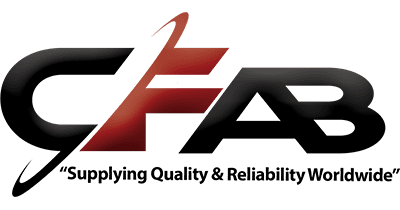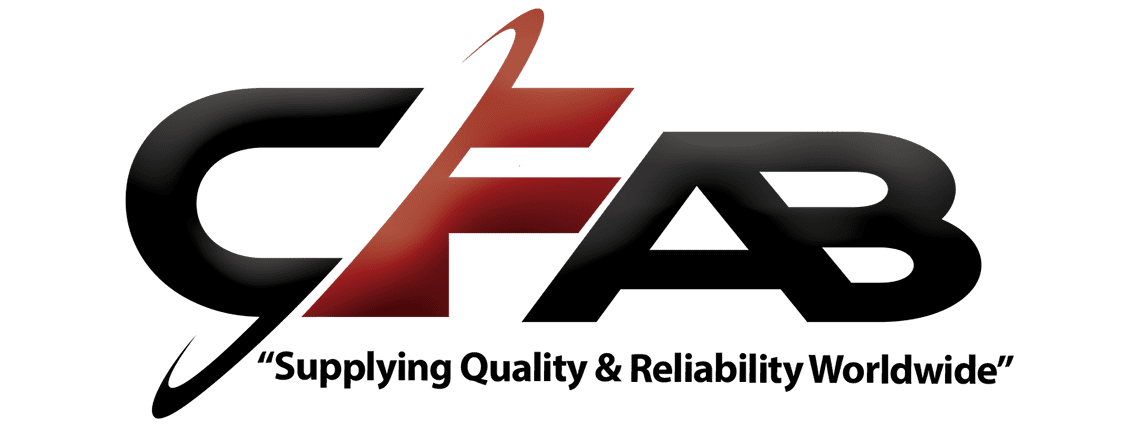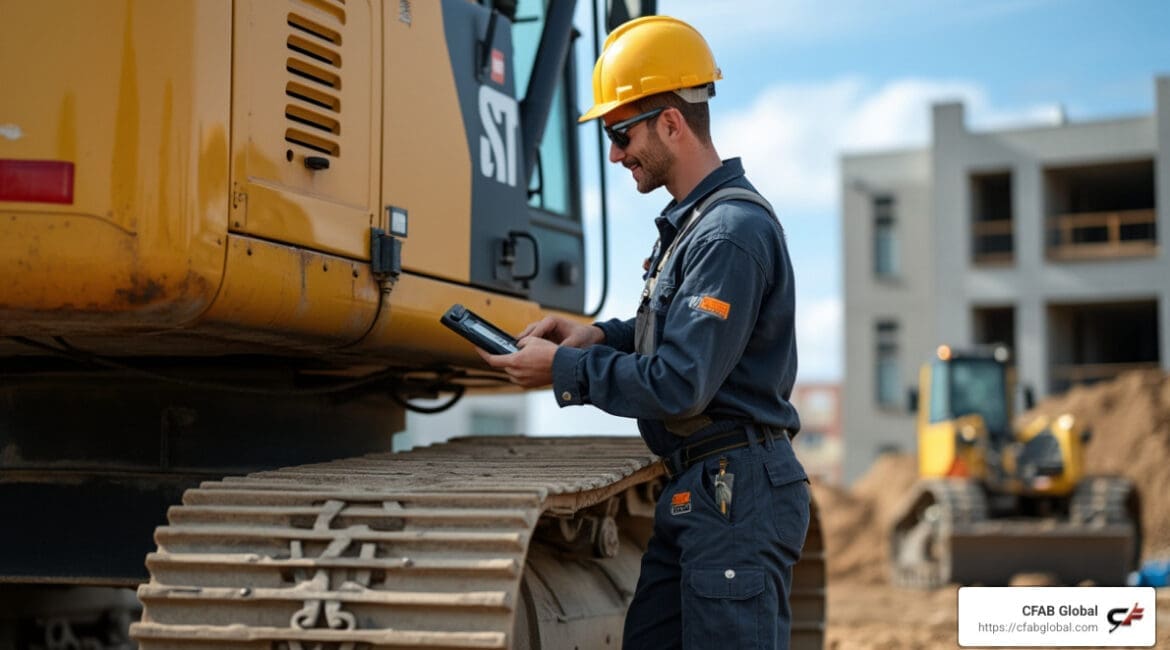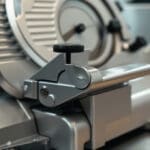Construction equipment repairs are critical for ensuring these powerful machines continue to perform efficiently. Whether you’re dealing with an excavator or a bulldozer, keeping your equipment in top shape eliminates the risk of unexpected downtimes and improves project timelines. Key solutions include:
- Regular Maintenance: Conduct scheduled check-ups to identify potential issues early.
- Advanced Diagnostics: Use diagnostic tools to pinpoint problems quickly and accurately.
- On-Site Repairs: Benefit from mobile repair services that minimize disruption and get your equipment back on track fast.
Why is maintenance crucial? Regular maintenance not only prolongs the lifespan of your equipment but also improves safety on construction sites. Without proper care, machinery is prone to more frequent and severe breakdowns, leading to costly repairs and halted projects.
I’m Todd Cleppe, with over 25 years in engineering, manufacturing, and process improvements, specializing in construction equipment repairs. My experience extends from designing automated lubrication systems to changing machinery across various industries. Next, let’s dig into understanding the basics of these repair needs.

Understanding Construction Equipment Repairs
Equipment maintenance is the backbone of keeping construction machinery running smoothly. It’s like giving your car a regular oil change and tire rotation. Without it, you risk costly breakdowns and delays on the job site.
Repair Classification: Construction equipment repairs can be categorized based on urgency and complexity.
- Preventive Maintenance: Routine tasks like oil changes and inspections that prevent bigger issues.
- Corrective Repairs: Fixes made after a problem is identified, like replacing a broken hydraulic hose.
- Overhaul and Rebuilds: Extensive work to restore older equipment to like-new condition.
Cost Factors: Several aspects influence the cost of repairs:
- Parts and Labor: The most obvious costs, which can vary based on the machinery’s make and model.
- Downtime: Every minute equipment is out of action costs money. Quick, efficient repairs minimize this.
- Diagnostic Tools: Advanced tools can identify issues faster, saving time and reducing labor costs.
Understanding these elements helps in planning budgets and ensuring that equipment remains operational and efficient.
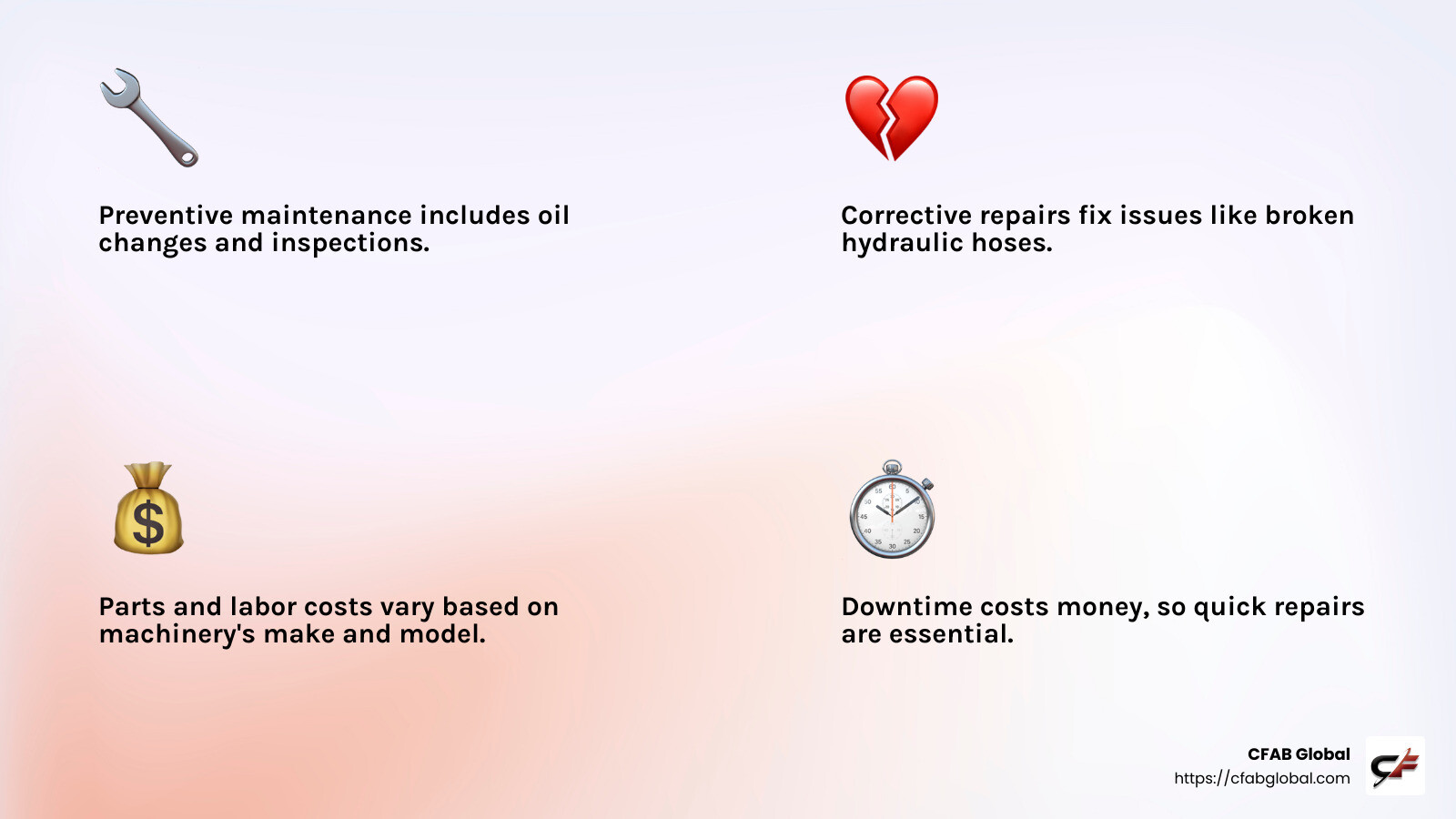
In the next section, we’ll explore essential repair solutions for construction equipment, focusing on planned maintenance and specific repair types like hydraulic and drivetrain repairs.
Essential Repair Solutions for Construction Equipment
When it comes to construction equipment repairs, having a strategic approach can save both time and money. Let’s dive into some essential repair solutions that keep your machinery in top shape.
Planned Maintenance
Think of planned maintenance as the routine check-up for your equipment. It’s like going to the dentist regularly to avoid cavities. By scheduling routine inspections and servicing, you can catch potential problems before they become costly breakdowns.
- Inspections: Regularly check critical components like belts, hoses, and filters.
- Lubrication: Ensure all moving parts are well-lubricated. For automated lubrication systems, consider Graco solutions for reliable performance.
- Software Updates: Keep your equipment’s software up-to-date to improve efficiency and functionality.
Planned maintenance is all about being proactive, not reactive. This approach maximizes uptime and extends the life of your machines.
Drivetrain Repair
The drivetrain is the powerhouse of your construction equipment. It includes components like the transmission, driveshaft, and axles. Any issues here can halt operations.
- Common Issues: Wear and tear can lead to slipping gears or strange noises.
- Repair Solutions: Address problems early with professional diagnostics and repair services. This might involve replacing worn-out gears or bearings.
Ensuring your drivetrain is in excellent condition means your equipment can handle the toughest jobs without a hitch.
Hydraulic Repair
Hydraulics are the muscles of construction equipment, powering everything from excavator arms to bulldozer blades. When hydraulic systems fail, it can bring projects to a standstill.
- Signs of Trouble: Leaks, slow operation, or loss of power indicate hydraulic issues.
- Repair Strategies: Regularly inspect hoses and seals. If a hydraulic component needs repair or replacement, it’s crucial to act fast to prevent further damage.
With expert hydraulic repair services, your equipment can continue to perform heavy lifting and digging tasks efficiently.
By focusing on these essential repair solutions, you can keep your construction equipment operating smoothly and efficiently. In the next section, we’ll explore advanced on-site repair services that bring the solution directly to your job site, minimizing downtime and maximizing productivity.
Advanced On-Site Repair Services
In the world of construction, downtime is a luxury most projects can’t afford. That’s where advanced on-site repair services come into play, ensuring that your equipment is fixed promptly and efficiently, right where it breaks down.
On-Site Repairs
Imagine your excavator suddenly stops working in the middle of a crucial project. Instead of halting operations and transporting the equipment to a repair shop, on-site repairs bring the service to you. This minimizes disruption and gets your machinery back to work faster.
- Quick Response: Trained technicians are dispatched to your location, armed with the necessary tools and parts to handle a variety of issues.
- Reduced Downtime: On-site repairs mean less waiting and more working, keeping your project on schedule.
Mobile Service Trucks
These are not just any service vehicles; mobile service trucks are essentially repair shops on wheels. They are equipped with the latest tools and technology to tackle even complex repairs on the spot.
- Diagnostic Equipment: Advanced diagnostic tools help technicians identify problems quickly and accurately.
- Comprehensive Tools: From wrenches to welding equipment, these trucks carry everything needed for most repairs.
With such capabilities, mobile service trucks ensure that your equipment is not out of action for long, saving both time and money.
Diagnostic Equipment
In construction equipment repairs, accurate diagnosis is half the battle. Using state-of-the-art diagnostic equipment, technicians can pinpoint issues with precision.
- Advanced Technology: Tools like digital multimeters and hydraulic testers provide detailed insights into equipment performance.
- Efficient Troubleshooting: Faster diagnosis means quicker repairs, getting your equipment back to optimal condition sooner.
By leveraging these advanced on-site repair services, you’re not just fixing problems—you’re preventing them from escalating. This proactive approach to equipment maintenance keeps your construction projects running smoothly and efficiently.
In the next section, we will explore how proactive maintenance strategies can help maximize the longevity of your equipment, ensuring it stays in peak condition for years to come.
Maximizing Equipment Longevity with Proactive Maintenance
Keeping construction equipment in top shape is crucial for minimizing downtime and maximizing productivity. Proactive maintenance is the key to achieving this, and it involves scheduled maintenance, predictive strategies, and uptime maximization.
Scheduled Maintenance
Regularly scheduled maintenance is like a health check-up for your equipment. It helps catch potential issues before they become major problems.
- Routine Inspections: By setting a maintenance schedule, you ensure that all parts are regularly checked and serviced. This reduces the risk of unexpected breakdowns.
- Cost Savings: Preventive maintenance can save money in the long run by avoiding costly repairs and extending equipment life.
Predictive Strategies
Predictive maintenance takes things a step further by using data and technology to anticipate when equipment might fail.
- Data Analysis: Using sensors and diagnostic tools, you can monitor equipment performance in real-time. This data helps predict failures before they occur.
- Condition-Based Monitoring: Instead of servicing equipment on a fixed schedule, maintenance is performed based on the actual condition of the equipment. This approach ensures that parts are only replaced when necessary, reducing waste and costs.
Uptime Maximization
The ultimate goal of proactive maintenance is to keep your equipment running as much as possible.
- Increased Reliability: With fewer unexpected breakdowns, your machinery is more reliable, ensuring projects stay on track.
- Improved Productivity: By maximizing uptime, your team can meet deadlines and increase overall productivity.
Proactive maintenance not only extends the life of your equipment but also improves operational efficiency. By investing in these strategies, you’re not just maintaining your machinery—you’re safeguarding your entire construction operation.
In the next section, we’ll address some frequently asked questions about construction equipment repairs, shedding light on common concerns and misconceptions.
Frequently Asked Questions about Construction Equipment Repairs
What is equipment maintenance in construction?
Equipment maintenance in construction is all about keeping machinery and vehicles in top working condition. This involves regular upkeep, such as oil changes, filter replacements, and routine inspections. Proper maintenance ensures that equipment operates efficiently and safely, reducing the likelihood of costly breakdowns. It’s like taking care of a car—regular check-ups and repairs extend its life and reliability.
Why is construction equipment so expensive?
Construction equipment is expensive due to several factors:
-
Supply and Demand: The demand for heavy machinery in construction and mining is high, driving up prices. When demand outpaces supply, costs naturally rise.
-
Market Saturation: In some regions, the construction equipment market is saturated with various brands and models. While this might seem like it would lower prices, it often leads to increased competition and innovation, which can drive up costs for the latest technology and features.
-
Advanced Technology: Modern construction equipment is equipped with sophisticated technology, such as GPS systems and automated controls, which add to the cost.
What should equipment repair be classified as?
Equipment repair should be classified as an equipment expense. In business accounting, this means it’s recorded as a cost necessary to maintain the operational capability of business equipment. Repairs are essential for keeping machinery in working order, thus supporting the overall business function. It’s important to differentiate between repair costs and capital expenditures, which are for acquiring new equipment or significantly upgrading existing assets.
Understanding these aspects of construction equipment repairs and maintenance can help you manage costs more effectively and ensure that your machinery remains in optimal condition. Up next, we’ll dive into more details about CFAB Global’s commitment to operational efficiency through our Machine Reliability Program.
Conclusion
At CFAB Global, we understand the critical role that operational efficiency plays in the construction industry. Our commitment to enhancing this efficiency is exemplified through our Machine Reliability Program. This program is designed to ensure that your construction equipment remains in peak condition, minimizing downtime and maximizing productivity.
CFAB Global: Your Trusted Partner
With years of experience in providing advanced machinery solutions, CFAB Global stands out as a leader in the field. We specialize in delivering custom services that meet the unique demands of various industries, including construction. Our expertise ensures that your equipment operates smoothly, reducing the risk of unexpected failures and costly repairs.
The Machine Reliability Program
Our Machine Reliability Program is not just a service—it’s a comprehensive strategy aimed at boosting the performance and lifespan of your machinery. By focusing on predictive maintenance and proactive solutions, we help you stay ahead of potential issues. This program includes:
- Personalized Analysis: We assess your equipment’s specific needs to develop a maintenance plan that fits your operations.
- Cutting-Edge Services: Our team uses the latest technology and techniques to keep your machinery running efficiently.
- Ongoing Support: From initial consultation to continuous monitoring, we’re with you every step of the way.
By investing in our Machine Reliability Program, you’re choosing a path that leads to increased uptime, reduced maintenance costs, and a better return on investment.
Achieving Operational Efficiency
Operational efficiency is more than just keeping machines running; it’s about optimizing every aspect of your equipment’s performance. With CFAB Global, you gain access to a team of specialists dedicated to ensuring your machinery meets the highest standards of reliability and productivity. Our proactive maintenance strategies are designed to prevent breakdowns before they occur, saving you time and money.
For more information on how CFAB Global can transform your machinery maintenance and boost your operational efficiency, visit our Heavy Machinery Maintenance Service page.
Choose CFAB Global for reliable construction equipment repairs and maintenance solutions that drive your business forward.
